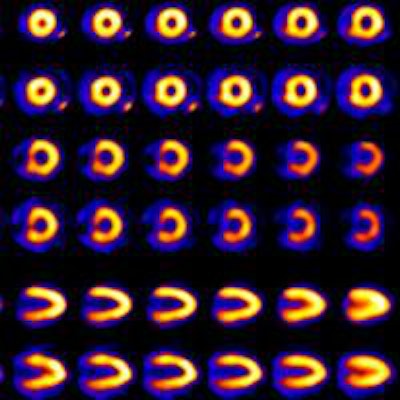
Patients with chest pain who underwent SPECT myocardial perfusion imaging (MPI) with an ultralow-radiation-dose gamma camera had no major cardiac events a year later. The research, published in the April issue of the Journal of Nuclear Medicine, indicates that MPI radiation dose can be slashed without adverse clinical impact.
Researchers from Columbia University Medical Center and NewYork-Presbyterian Hospital in New York City found that a majority of patients who were scanned with the low-dose system had no major adverse cardiac events, did not have to return to the hospital for chest pains, and required no follow-up imaging or stress testing within three months of their emergency department visit. In addition, all 100 patients in the study remained free of any acute coronary symptoms one year later.
 Dr. Andrew Einstein, PhD, from Columbia University Medical Center and NewYork-Presbyterian Hospital.
Dr. Andrew Einstein, PhD, from Columbia University Medical Center and NewYork-Presbyterian Hospital."Ultimately, patient outcomes are most important, and we demonstrated that by using this very low-dose protocol, where patients averaged a radiation dose of about 2 mSv," said lead author Dr. Andrew Einstein, PhD, associate professor of medicine in radiology and co-director of cardiac CT and MRI at both facilities. "If you look at the 69% of the patients who were able to undergo stress-only imaging, they averaged just under 1 mSv in terms of their radiation dose."
Radiation exposure
Previous studies have estimated that radiation dose for nuclear stress tests in the U.S. typically can range from 10 mSv to 15 mSv, Einstein told AuntMinnie.
"That is the equivalent of three to five years of background radiation and the equivalent of many hundreds of chest x-rays," he added. "So we were interested in obtaining this very useful information, provided by myocardial perfusion SPECT, without this high radiation burden."
This most recent study is a follow-up to research Einstein and colleagues published last year in which they compared image quality from an ultralow-dose, high-efficiency SPECT camera (D-SPECT, Spectrum Dynamics) with a standard low-dose SPECT scan (e.cam or Symbia, Siemens Healthcare; Forte, Philips Healthcare). The D-SPECT camera uses digital cadmium zinc telluride detectors, which Spectrum Dynamics claims has 10 times the sensitivity of conventional sodium iodide scintillation crystals.
The ultralow-dose SPECT MPI scan achieved better image quality than standard low-dose SPECT, the researchers concluded. They also noted that assessment of extracardiac activity, overall perfusion, and ejection fraction was comparable between the scans and was accomplished at a dose of 1 mSv, which is less than half the dose of standard low-dose SPECT (JNM, September 2014, Vol. 55:9, pp. 1430-1437).
"We do a lot of nuclear stress testing," Einstein said. "It provides outstanding information in terms of diagnosing coronary disease, establishing prognosis of patients, and it is an integral part of contemporary cardiovascular practice. But it is associated with the radiation burden, which is perceived by some to be high."
The reason for the current study, he added, is that no previous research has been conducted to assess clinical outcomes of patients who were imaged using stress-first or stress-only ultralow-dose SPECT as part of their emergency department inpatient evaluation for chest pain.
Researchers prospectively enrolled 100 patients who initially presented with chest pain to the two hospitals' emergency departments. The facilities performed myocardial perfusion SPECT imaging only on patients with level 3 chest pain during their hospitalization.
"These are patients who you don't think are having a heart attack, but you think they should have some testing done to make sure it is safe to leave the hospital," Einstein explained. "That way we are not missing a heart attack. These are the patients who can really benefit by a fast, low-radiation-dose stress test."
Dose and scan time
As part of their clinical care, all patients underwent exercise or pharmacologic stress testing with regadenoson or 140 mg/kg/min of adenosine over six minutes. A 185-MBq (5-mCi) unit dose of technetium-99m tetrofosmin (Myoview, GE Healthcare) also was administered.
Stress-first MPI was performed with patients in the supine and prone positions some 30 to 60 minutes after administration, using 15-minute acquisition times (Discovery NM 530c, GE Healthcare).
Radiation dose averaged 2.22 mSv for all 100 patients. Of all 100 patients, 69 individuals (69%) had normal stress imaging results and did not require follow-up rest imaging. The effective radiation dose for these 69 cases averaged 0.99 mSv with a study duration of 117 minutes.
For the 31 patients (31%) undergoing stress and rest imaging, study duration time was approximately four hours (mean time of 241 minutes, ranging from 193 to 428 minutes). Of these patients, 18 people had normal perfusion.
 Myocardial perfusion images from normal stress-only study performed on ultralow-dose high-efficiency camera. The top rows are supine images, while bottom rows were acquired in prone position. Radiation effective dose for the study was 0.93 mSv. Images courtesy of the Journal of Nuclear Medicine.
Myocardial perfusion images from normal stress-only study performed on ultralow-dose high-efficiency camera. The top rows are supine images, while bottom rows were acquired in prone position. Radiation effective dose for the study was 0.93 mSv. Images courtesy of the Journal of Nuclear Medicine.The key finding is that three months after ultralow-dose SPECT, 96 patients (96%) were still alive, did not suffer from a heart attack or unstable angina, did not require repeat emergency department visits for chest pain, and did not need follow-up stress testing or other cardiac imaging.
"It is important that the prognosis was excellent, with only 4% of patients requiring additional cardiac imaging or presenting again to the hospital for chest pain evaluation within three months, and no deaths or acute coronary syndromes at one year," the authors wrote. "Thus, stress-first ultralow-dose MPI using a high-efficiency SPECT camera represents a potentially important approach to reduce radiation dose and length of stay, while still ensuring safe discharge, in patients presenting to the hospital with chest pain."
"I think this is a starting point to consider whether it is possible to have a patient imaged for a slightly shorter period of time, while still obtaining this information," Einstein added. "I suspect the answer is yes, but it was not demonstrated by this study."
If there were any surprises in the findings, Einstein said it was the proportion of patients who did not need rest imaging to evaluate their cardiac condition.
"I think it is a testament to the robustness of the test, at least in this patient population," he said. "If you don't have a high-risk patient population, most of these patients should be able to be evaluated using stress only imaging in conjunction with a high-efficiency [SPECT] camera, which can really keep radiation dose low, while remaining on label in terms of the amount of radiopharmaceutical administered."




















